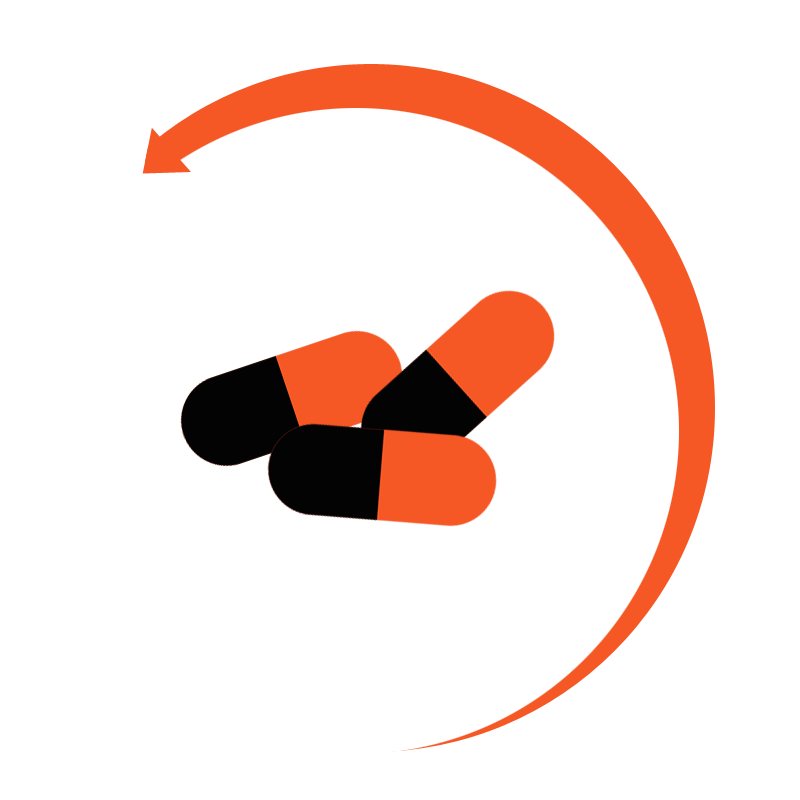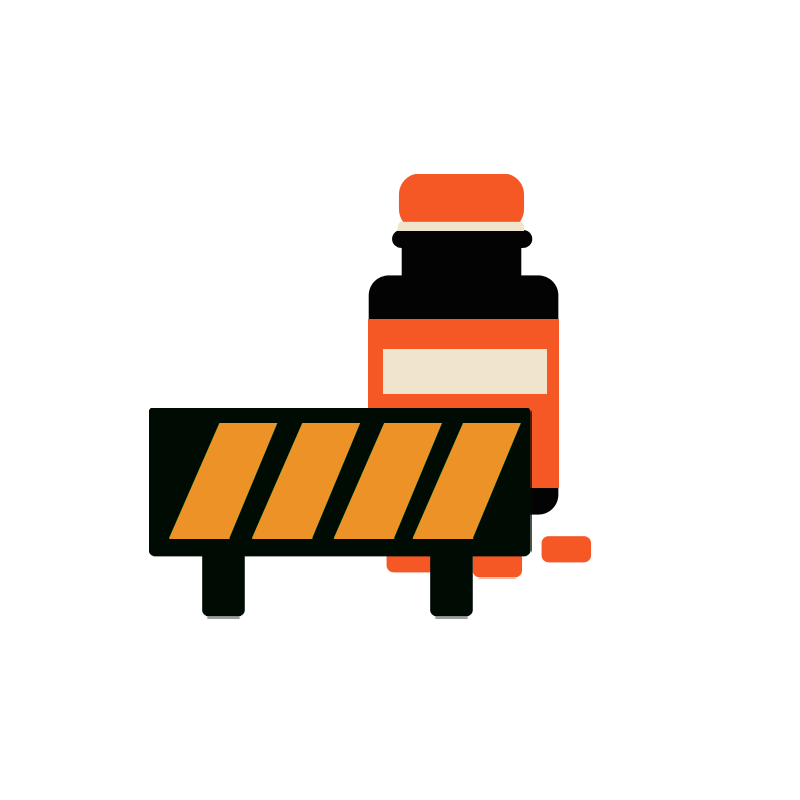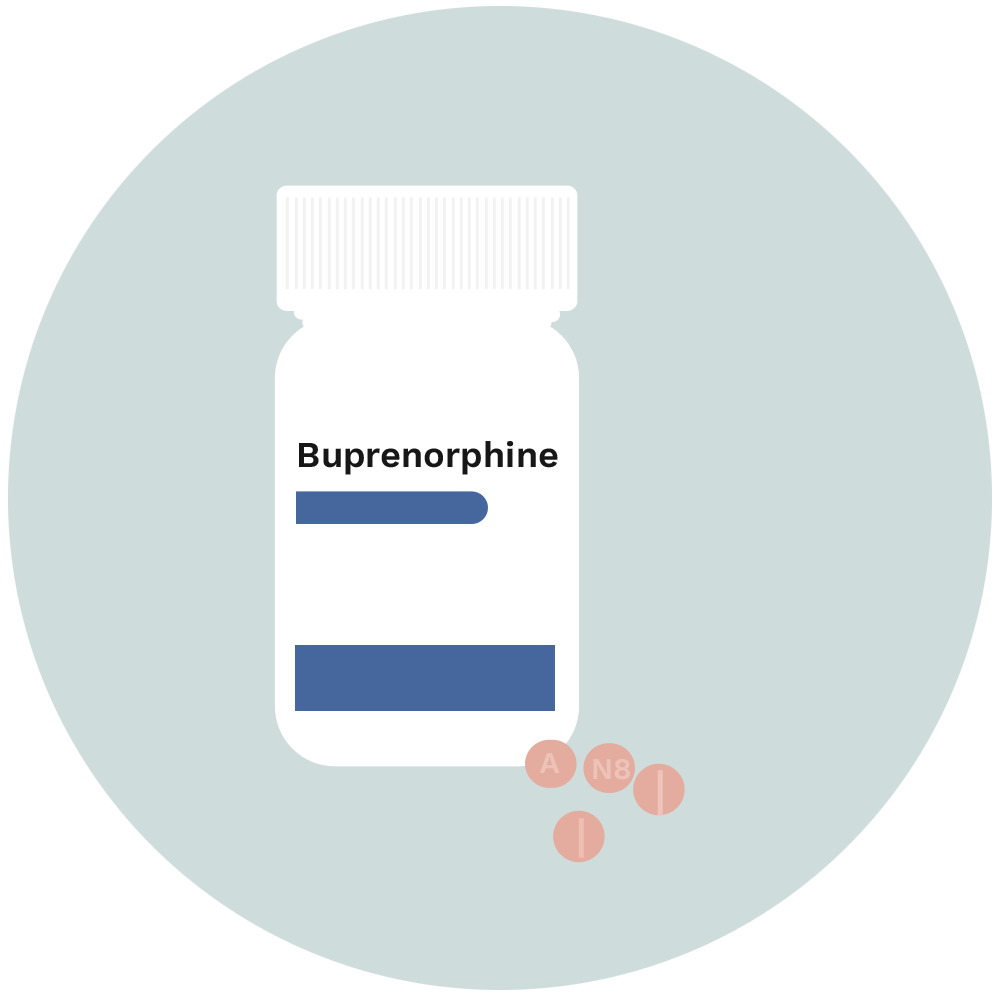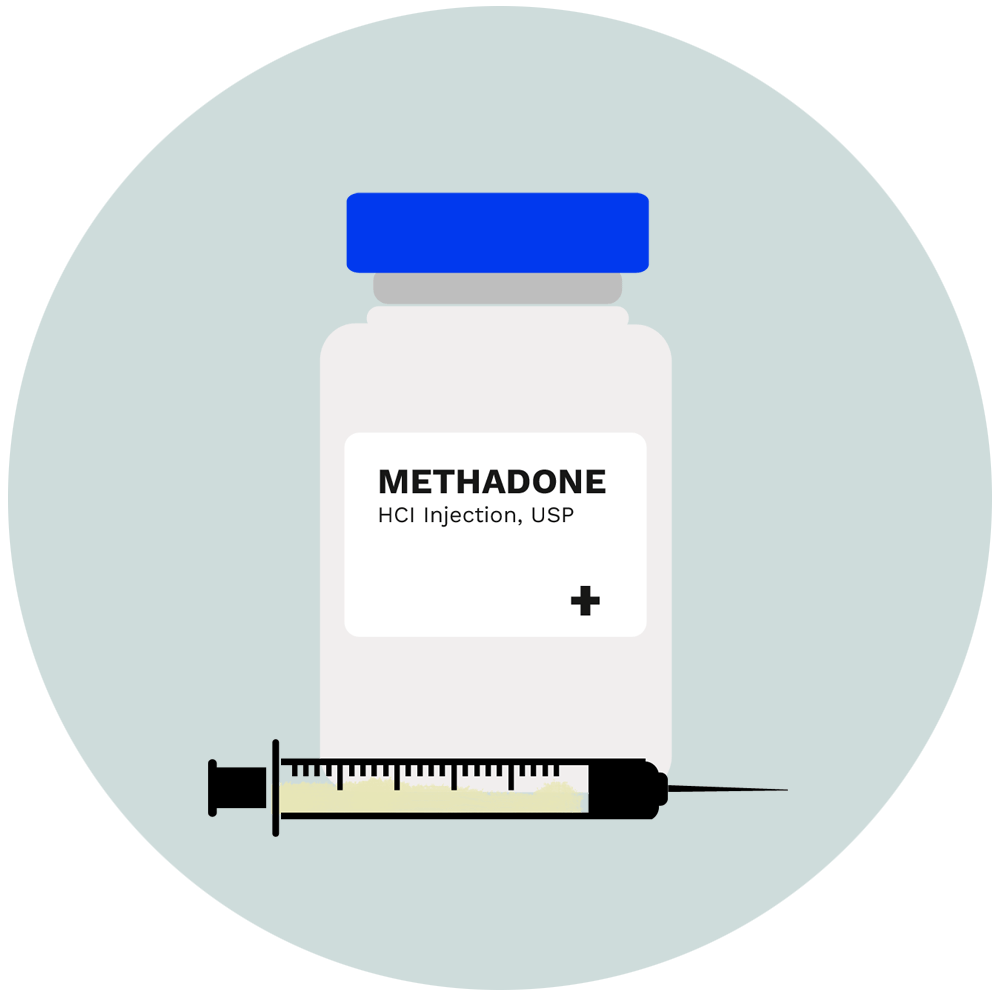Medication Assisted Treatment
Today, more than 22 million Americans struggle with substance use disorders. With over 70,000 drug-overdose related deaths in 2017, substance use disorder is a medical problem of epidemic proportions, costing hundreds of lives each day.
While new measures to control and regulate opioids have reduced some deaths in recent years, millions of Americans still need treatment. Increasingly, that treatment occurs in the form of Medication-Assisted Treatment or MAT.

Medication-Assisted Treatment or MAT refers to a series of FDA and SAMHSA approved treatments used to reduce withdrawal symptoms, minimize cravings, and increase the likelihood of recovery. In most cases, Medication-Assisted Treatments are part of drug and alcohol rehabs that include counseling and behavioral health therapy. Most medications also include preventive measures to reduce instances of abuse, strict management programs, and timelines designed to help individuals taper off the treatment after a set or agreed-upon time period. Medication-Assisted Therapy has been shown to improve outcomes in most patients, is safe for most people and improves the comfort and safety of individuals while withdrawing from opioids.
At the same time, Medication-Assisted Treatment has a somewhat controversial reputation, primarily relating to the use of opioid-based drugs treatment. Individuals seeking out opioid addiction treatment or alcohol addiction treatment should learn as much as possible before deciding to enter a MAT program. In addition, you should talk to your counselor, your doctor and to a treatment specialist to review your options based on your substance use disorder, medical history and mental health.
The information on this page is intended to inform your decisions but should not be substituted for a consultation with a medical professional.
What is Medication-Assisted Treatment?

Medication Assisted Treatment (MAT), also known as Opioid
Replacement Treatment (ORT) consists of any of several treatments combining an opioid replacement or blocker along with counseling and behavioral health therapy. Depending on the program and the institution offering the treatment, Medication-Assisted Treatment will take place as part of an initial detox and withdrawal, throughout treatment, or after treatment. In some cases, MAT programs will consist of all three phases.
MAT programs typically work by replacing opioids or other substances with longer acting and less euphoric alternatives.
These alternatives, buprenorphine and methadone, can be combined with opioid antagonists such as Naloxone, which functions to block the effects of opioids to reduce the potential for abuse. The idea is that patients using ORT can achieve mental and physical stability, which they can use to facilitate behavioral health treatment, to resume their life and to reduce the impacts of the drug and withdrawal on their system. This helps patients return to work or family care, to reduce or abstain from continued substance abuse and to avoid many of the personal, fiscal and health complications of illicit substance abuse.
MAT programs typically first work to reduce the risks of overdose and health complications and then work to help people recover. In some settings, they’re used primarily for health purposes, by reducing illicit substance abuse in individuals at crisis centers and open treatment facilities.
TYPES OF MEDICATION-ASSISTED TREATMENT
Medication-Assisted Treatment is used to treat opioid use disorder, alcohol addiction, and, in some cases, smoking addiction. MAT is most commonly used to treat opioid use disorder, because most replacement therapy substances work with opioids.
Medication-Assisted Treatment for Opioids
Most Medication-Assisted Treatment programs are designed for opioids. Drugs including Buprenorphine, Naltrexone and Methadone are used to treat opioid use disorder, in combination with other therapies.
the Preferred MAT Drugs used At Broadway Treatment Center
Sublocade
Sublocade is designed to deliver buprenorphine at a controlled rate over a one-month period and provides a sustained level of buprenorphine in the bloodstream throughout the month. Sublocade blocks the rewarding effects of opioids and allows for a comfortable and effective transition away from opioid use.
At Broadway Treatment Center we have found that the once-monthly dose of Sublocade, as opposed to daily or multiple daily doses of other MAT drugs, makes it far easier for our clients to recover from opioid addiction.
In a 24-week clinical study, people who received Sublocade plus counseling were more likely to have weeks without opioid use compared with people who received a placebo injection (injection with no medication) plus counseling.
Vivitrol
Vivitrol is an extended release form of Naltrexone and is an antagonist or opioid blocking medication. Vivitrol is injected intramuscularly once per month and released into the bloodstream at a controlled rate.
Vivitrol blocks opioid receptors in the brain for one month at a time, helping patients to prevent relapse to opioid dependence, following opioid detox, while they focus on counseling. Patients must be opioid-free before starting Vivitrol.
Our experience at Broadway Treatment Center is that the once-monthly dose of Vivitrol is highly effective for treatment of opioid addiction, because clients know they can not achieve a euphoric high from opioids for at least one month. This one month period allows them to transition into full recovery, by which time their craving for opioids is typically diminished or gone altogether.
Phases of Medication assisted treatment

Early Recovery
Here, drugs such as Naltrexone and Buprenorphine are administered to reduce cravings and reduce withdrawal symptoms. This can help individuals to recover more quickly, because they avoid negative and possibly dangerous or traumatic side-effects of withdrawal. It also allows individuals to continue working or maintaining personal responsibilities while attending an outpatient treatment program, essentially allowing the individual to get back to their life. This makes treatment more accessible and affordable for millions. ORT’s are typically opioids that are used to stimulate the brain without causing euphoria or a “high”. Individuals therefore don’t experience any of the effects of opiate usage, but also don’t experience cravings or withdrawal. This also means individuals can directly move into therapy. In other cases, drugs used in early recovery are opioid agonists like Naloxone. This drug blocks opioids and their effects, typically causing immediate withdrawal symptoms. This treatment can be dangerous and is only offered as part of “Rush” detox programs.
Note that while Methadone is a MAT drug, it is used only in specially regulated clinics and is described more fully below.

Maintenance Therapy
Maintenance Therapy involves ongoing buprenorphine or Naltrexone dosage, typically meted out over a period of 3-24 months. In most cases, these programs involve regular trips to a doctor, regular checkups and ongoing therapy and complimentary therapy such as self-help groups, behavioral therapy and counseling. In most cases, maintenance programs use combinations of opioids and opioid receptor agonists to prevent abuse and typically include other abuse-preventive measures such as making the drug difficult to inject.
Medication assisted opioid treatment has been shown to improve outcomes and is recommended as a first-option by the World Health Organization, SAMHSA and NIDA.
Get Your Questions Answered Now.
MEDICATION-ASSISTED TREATMENT FOR ALCOHOL
Individuals with drinking problems can seek out Medication-Assisted Treatment for alcohol. These programs use two types of medication:

Maintenance Drugs
Drugs like Disulfiram and Acamprosate are used for maintenance, treating alcohol use disorder after detox. These drugs function by causing unpleasant effects following alcohol consumption, such as nausea and vomiting or near-immediate withdrawal effects.

Blockers
Naltrexone is used in alcohol addiction treatment to block the euphoric and intoxicating effects of alcohol. This allows individuals to slip up without the “reward” of drinking, which helps many to stay in treatment and continue their journey to recovery.
Medication-Assisted Treatment for alcohol use disorders are combined with recognized treatments for substance use disorder, such as behavioral therapy and counseling.
Medicines Used in MAT Programs
MAT programs use different medications depending on the goal of treatment and what is being treated. In most cases, opioid substance use disorder treatment programs use Methadone, Buprenorphine and Naltrexone. Alcohol substance abuse treatment programs will more-often use Naltrexone, Acamprosate and Disulfiram.

Buprenorphine
Buprenorphine is one of the most popular MAT drugs and unlike Methadone, may be administered by most medical practitioners licensed to dispense medication. This allows more freedom and more options to seek treatment for individuals, especially those in states without OTP facilities.
Subutex – Subutex is the primary brand of buprenorphine, sold as a film or tablet which is taken under the tongue. Injectables and chips are also in-use, with the once-per-month extended release injectable Sublocade being the most common. Subutex works by binding with opioid receptors and blocking additional opioids, preventing a “high” in users. Because Subutex is an opioid, it also prevents cravings and withdrawal symptoms in existing users. Subutex has a lower addiction-potential than methadone, meaning users can more safely take it without supervision. However, the potential for abuse still exists and most pills include abuse-prevention standards to prevent the pills from being ground and injected.
Suboxone – Suboxone is a specialty formulation of buprenorphine and naloxone, typically distributed as a film to be taken under the tongue. Naloxone is an opioid antagonist, which blocks the effects of opioids. This allows individuals to benefit from reduced cravings and withdrawal symptoms, while preventing abuse because Naloxone is poorly abused through the mucosal membranes of the mouth. Individuals who inject or snort Suboxone to get high receive the full dose of Naloxone, preventing a “high” and typically causing withdrawal symptoms. This greatly reduces the potential for abuse and therefore the need for management.
Sublocade is an injectable form of buprenorphine designed to deliver buprenorphine at a controlled rate over a one-month period. In a 12-week study of 39 non-treatment-seeking adults Sublocade blocked the rewarding effects of opioids.

Naltrexone
Naltrexone is used to block the effects of substances such as opiates and alcohol. The drug binds and blocks opioid receptors, directly preventing individuals from getting “high” off opioids such as heroin, fentanyl, or methamphetamine. It is strongly recommended that individuals fully detox and remain abstinent for a minimum of 7-10 days before beginning a course of Naltrexone. Like Methadone, Naltrexone is typically offered as a daily dose, typically at 50mg, and may be administered by any medically licensed physician.
It is crucial that individuals on a Naltrexone program continue to seek out therapy and behavioral therapy. Individuals who relapse do not feel the effects of opiates they might take, but are still at risk of complications including respiratory failure, heart problems and overdose.
For alcohol treatment, Naltrexone blocks euphoria and intoxication. This helps individuals to stay sober and prevents relapse by reducing the reward and effect of drinking.
Vivitrol – Vivitrol is an extended-release injectable version of Naltrexone, designed to increase time between visits. Vivitrol is injected intramuscularly once per month, allowing individuals more freedom than daily visits or daily pills.

Methadone
Methadone is one of the most popular drugs used in opioid treatment. Methadone is an opioid drug and opioid receptor agonist, used to reduce cravings, reduce withdrawal symptoms, and reduce or block the effects of other opioids. Methadone is distributed from specialty clinics registered as an Opioid Treatment Programs (OTP) which can be found through SAMHSA’s official registry. These facilities must pass strict legal and medical guidelines to legally offer methadone treatment.
Methadone treatment is typically 12 months but may be longer or shorter depending on advice from your doctor or physician. Doses are carefully scaled to meet the individual’s body, genetic and substance abuse. Here, patients receive a daily dose of liquid, powder, or a wafer, which is handed out and administered in the treatment facility.
Methadone is also used for short-term detox treatment, where individuals are given the drug at a dosage high enough to prevent withdrawal symptoms from another drug, and then slowly tapered down until the individual is no longer on the drug. This type of detox therapy is typically combined with Suboxone, which has a lighter withdrawal profile.
While methadone is an opioid drug, it does not typically cause sedation or euphoria, but may cause respiratory issues and heart problems if abused. In most cases, methadone doses are adjusted and readjusted throughout treatment and it is crucial for individuals to take the correct dosage throughout treatment. Methadone can be habit forming, which is why its use and distribution are tightly regulated.
Acamprosate
Acamprosate is the preferred medication assisted treatment for alcohol use disorder. The drug is prescribed after abstinence, typically on day 5 of a detox program, and taken 3 times per day. The drug reduces withdrawal symptoms and cravings by affecting GABA receptors in the brain and may help protect the brain from adverse neural side-effects of withdrawal. Acamprosate is typically prescribed for 3-12 months after initial abstinence.
Disulfiram
Disulfiram is a second-line treatment for alcohol use disorder, with both Acamprosate and Naltrexone being preferred. The drug is prescribed as a tablet to be taken once per day, following a minimum of 5 days of abstinence. The drug blocks production of acetaldehyde dehydrogenase in the body, which greatly increases the quantity of acetaldehyde, one of the primary causes of a hangover. Individuals taking disulfiram experience severe hangover-like side effects within 5-10 minutes of drinking, with headaches, nausea, vomiting, blood pressure changes, respiratory difficulty and anxiety all being common. Disulfiram is only recommended for individuals who are taking treatment.
In some cases, drugs including Modafinil, Gabapentin, N-Acetyl Cysteine and SSRIs are used to treat addictions to drugs including marijuana, amphetamines and opiates. These off-label uses vary considerably and it is important to consult with your doctor before using a drug for any non-FDA or off-label purpose.
How Does Medication Assisted Treatment Work in Rehab?
 A treatment facility offering medication assisted treatment will use medication assisted treatment in combination with other treatments. Federal regulations including the Narcotic Addiction Treatment Act of 1974 and Federal Regulations 42 CFR 8 strictly control how and where opioid treatment medication can be administered.
A treatment facility offering medication assisted treatment will use medication assisted treatment in combination with other treatments. Federal regulations including the Narcotic Addiction Treatment Act of 1974 and Federal Regulations 42 CFR 8 strictly control how and where opioid treatment medication can be administered.
Here, treatment facilities are required by law to administer counseling and behavioral therapy alongside MAT programs. This means that medication assisted therapy will only ever be part of treatment, in both detox and maintenance therapy situations.
Is Medication-Assisted Treatment Effective?
Medication-Assisted Treatment is widely regarded to be effective in that it improves outcomes, reduces fatalities and hospitalization, and increases the length of abstinence in most patients. However, MAT is not a cure for addiction. Individuals who take methadone or suboxone without seeking treatment are likely to relapse as soon as they stop the program. This means that MAT programs are just one aspect of successful substance use disorder treatment.
MAT programs are proven to be substantially more effective than abstinence-only treatment for opioid use disorder. With clinical reviews showing an average relapse rate as much as 40% lower than abstinence-based treatments at 3 months and 12 months, medication-assisted treatment is significantly able to help patients maintain recovery. However, relapse and continued abstinence rates heavily depend on the rest of the treatment, including behavioral therapy, counseling and ongoing support for the patient.
Controversies Surrounding MAT Programs
MAT programs are often viewed with suspicion, stigma and mistrust. Many individuals are under the impression that MAT programs swap one drug out for another, allow the user to “get high”, or enable continued addictions. These misconceptions have heavily reduced the adoption of medication assisted treatment in the United States.
MAT Programs Substitute One Drug for Another – MAT drugs do not cause a high, are safe and stable to use over the long-term and allow individuals to recover and seek out treatment for underlying causes of addiction. MAT programs are also temporary, with most not exceeding one year.
People who Choose MAT are “Giving Up” – MAT programs are historically associated with the conception that the patient is “weak willed” and can’t get off opioids on their own. MAT programs are heavily designed to reduce the risk of relapse and the high risk of overdose and death associated with relapse after abstinence, making them the safer and healthier choice for most individuals.
12-Step Groups Won’t Accept MAT Patients – Some believe that 12-step groups like AA or NA may look down on those using MAT. But in reality 12-step groups are designed to be inclusive and welcoming of anyone who wants to stay clean and sober. In fact, 12-step groups have traditions that support this goal, and any group that doesn’t follow these traditions should be avoided anyway.
Pros and Cons of Medication-Assisted Treatment
Medication-Assisted Treatment is one treatment option but not the only option. It’s crucial to discuss your needs, goals, and medical history with your physician and the prescribing physician before continuing.
CON: MAT and Other Medications – Medication-Assisted Therapy can cause complications when individuals have prescriptions for other medications. Here, it’s crucial to discuss your needs with your doctor and prescribing physician. Most MAT drugs will have some interactions with other substances, which must be managed carefully.
CON: Risks – Patients following MAT programs will experience side effects, including ongoing opioid usage symptoms. Patients are also at a high risk of overdose should they relapse. Some patients experience toxicity syndrome relating to buprenorphine or methadone. In addition, individuals who attempt to abuse buprenorphine or methadone may suffer respiratory failure and even death.
CON: Time Intensive – Most MAT programs require significant time investment over the course of a year. Individuals who cannot visit a doctor’s office or clinic every day or week will not benefit from the program.
CON: Withdrawal – All MAT drugs include some withdrawal period. This is typically mitigated using tapering programs to reduce symptoms. This ties into the risk of dependence, because opioids are dependence-inducing. Users must strictly follow prescriptions to prevent substance dependence and addiction.
PRO: Reduced Withdrawal Symptoms – MAT programs allow patients to quickly move from detox and into treatment, without dangerous or traumatic withdrawal symptoms. This is especially important for individuals suffering disorders such as PTSD, bipolar disorder, or anxiety who may not cope with the anxiety and paranoia induced by withdrawal.
PRO: Safety – MAT programs significantly increase the safety of individuals recovering from substance use disorders, reduce the risk of relapse and reduce days where substances are taken in individuals who have not yet fully recovered. This greatly reduces physical, fiscal and personal side-effects, allowing individuals to begin to recover from drug abuse.
PRO: Effective – Studies clinically establish that MAT greatly improves outcomes from drug treatment programs.
While Medication-Assisted Treatment has been contested, it is largely a good choice for most people. Talk to your doctor to assess your options, discuss your medical history, and determine what might be a good choice for you. In most cases, it’s a good idea to seek out a physician specializing in addiction treatment rather than a general practitioner, who may be unfamiliar with medication assisted treatment and its preparations.
Seeking Mediation-Assisted Treatment
 If you or a loved one is struggling with a substance use disorder, it’s important to seek out help. A rehab facility will offer detox, behavioral therapy, counseling and the tools to build the skills that will help you return to a happy, healthy, drug-free life. If desired, you may ask for or seek out a medication-assisted program.
If you or a loved one is struggling with a substance use disorder, it’s important to seek out help. A rehab facility will offer detox, behavioral therapy, counseling and the tools to build the skills that will help you return to a happy, healthy, drug-free life. If desired, you may ask for or seek out a medication-assisted program.
However, the resident physician will determine for you if this is necessary or beneficial based on your health, drug use, history of treatment and genetics. Most pharmacological treatment is based on extensive testing and review of medical records to ensure that the treatment is a good fit for you.
GET IN TOUCH
If you have questions about Medication-Assisted Treatment or any of our substance abuse treatment programs, please don’t hesitate to reach out to our staff. We are open 24 hours a day, 7 days a week, and if we aren’t able to help, we can refer you to someone who can.
